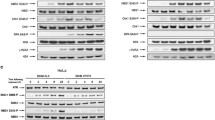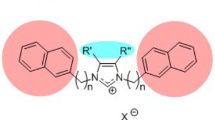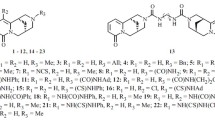Summary
The successful treatment of cancer requires the identification of new drugs with novel actions.N-[2-(Dimethylamino)ethyl]acridine-4-carboxamide dihydrochloride (DACA) is a topoisomerase II-targeted antitumour drug with curative activity against murine Lewis lung carcinoma. DACA was assessed for novel patterns of growth inhibition using normal and multidrug-resistant human cell lines. Cells were cultured in 96-well microtitre trays and tested against DACA and related topoisomerase-directed drugs, including amsacrine, etoposide and doxorubicin, and drug concentrations for 50% growth inhibition (IC50 or GI50 values) were determined. In a series of Jurkat leukaemia lines characterised as exhibiting atypical multidrug resistance, DACA was to a large extent capable of overcoming multidrug resistance exhibited towards the other topoisomerase-directed agents. DACA was also tested against the National Cancer Institute 60-tumour-specific cell-line panel (GI50 values ranging from 420 to 5,400 nM; mean, 2,100 nM) and against a series of primary cultures of surgically excised melanomas (IC50 values ranging from 60 to 1,600 nM; mean, 590 nM). DELTA values (deviations of logarithmic IC50 or GI50 values from the mean) were calculated and compared by correlation analysis. The standard deviation of DELTA values was found to be lower for DACA than for the other topoisomerase II-directed drugs amsacrine, etoposide, doxorubicin and mitozantrone in both the cell lines and the primary cultures. These lower standard deviations appear to have resulted from the reduced susceptibility of DACA to both P-glycoprotein- and topoisomerase II-mediated multidrugresistance mechanisms occurring naturally in cell lines and primary cultures.
Similar content being viewed by others
References
Alley MC, Scudiero DA, Monks A, Hursey ML, Czerwinski MJ, Fine DL, Abbott BJ, Mayo JG, Shoemaker RH, Boyd MR (1988) Feasibility of drug screening with panels of human tumor cell lines using a microculture tetrazolium assay. Cancer Res 48: 589–601
Atwell GJ, Rewcastle GW, Baguley BC, Denny WA (1987) Potential antitumor agents: 50. In vivo solid tumor activity of derivatives ofN-[2-(dimethylamino)ethyl]-acridine-4-carboxamide. J Med Chem 30: 664–669
Baguley BC, Holdaway KM, Fray LM (1990) Design of DNA intercalators to overcome topoisomerase II-mediated multidrug resistance. J Natl Cancer Inst 82: 398–402
Beck WT (1987) The cell biology of multiple drug resistance. Biochem Pharmacol 36: 2879–2888
Deffie AM, Alam T, Seneviratne C, Beenken SW, Batra JK, Shea TC, Henner WD, Geldenberg GJ (1988) Multifactorial resistance to Adriamycin: relationship of DNA repair, glutathione transferase activity, drug efflux, and P-glycoprotein in cloned cell lines of Adriamycin-sensitive and-resistant P388 leukemia. Cancer Res 48: 3595–3602
Devore RF, Corbert AH, Osheroff N (1992) Phosphorylation of topoisomerase II by casein kinase II and protein kinase C — effects on enzyme-mediated DNA cleavage/religation and sensitivity to the antineoplastic drugs etoposide and 4′-(9-acridinylamino)methanesulfon-m-anisidide. Cancer Res 52: 2156–2161
Endicott JA, Ling V (1989) The biochemistry of P-glycoprotein-mediated multidrug resistance. Annu Rev Biochem 58: 351–375
Finlay GJ, Baguley BC (1989) Selectivity ofN-[2-dimethylamino)ethyl]acridine-4-carboxamide towards Lewis lung carcinoma and human tumour cell lines in vitro. Eur J Cancer Clin Oncol 25: 271–277
Finlay GJ, Baguley BC, Wilson WR (1984) A semiautomated microculture method for investigating growth inhibitory effects of cytotoxic compounds on exponentially growing carcinoma cells. Anal Biochem 139: 272–277
Finlay GJ, Wilson WR, Baguley BC (1986) Comparison of in vitro activity of cytotoxic drugs toward human carcinoma and leukaemia cell lines. Eur J Cancer Clin Oncol 22: 655–662
Finlay GJ, Baguley BC, Snow K, Judd W (1990) Multiple patterns of resistance of human leukemia cell sublines to amsacrine analogues. J Natl Cancer Inst 82: 662–667
Friche E, Danks MK, Schmidt CA, Beck WT (1991) Decreased DNA topoisomerase II in daunorubicin-resistant Ehrlich ascites tumor cells. Cancer Res 51: 4213–4218
Haldane A, Finlay GJ, Gavin JB, Baguley BC (1992) Unusual dynamics of killing of cultured Lewis lung cells by the DNA-intercalating antitumour agentN-[2-(dimethylamino)ethyl]acridine-4-carboxamide. Cancer chemother Pharmacol 29: 475–479
Keepers YP, Pizao PE, Peters GJ, Ark-Otte J van, Winograd B, Pinedo HM (1991) Comparison of the sulforhodamine B protein and tetrazolium (MTT) assays for in vitro chemosensitivity testing. Eur J Cancer 27: 897–900
Liu LF (1989) DNA topoisomerase poisons as antitumor drugs. Annu Rev Biochem 58: 351–375
Marshall ES, Finlay GJ, Matthews JHL, Shaw JHF, Nixon J, Baguley BC (1992) Microculture-based chemosensitivity testing: a feasibility study comparing freshly explanted human melanoma cells with human melanoma cell lines. J Natl Cancer Inst 84: 340–345
Monks A, Scudiero D, Skehan P, Shoemaker R, Paull K, Vistica D, Hose C, Langley J, Cronise P, Vaigrowolff A, Graygoodrich M, Campbell H, Mayo J, Boyd M (1991) Feasibility of a high-flux anticancer drug screen using a diverse panel of cultured human tumor cell lines. J Natl Cancer Inst 83: 757–766
Mosmann T (1983) Rapid colorimetric assay for cellular growth and survival: application to proliferation and cytotoxicity assays. J Immunol Methods 65: 55–63
Nooter K, Herweijer H (1991) Multidrug resistance (mdr) genes in human cancer. Br J Cancer 63: 663–669
Paull KD, Shoemaker RH, Hodes L, Monks A, Scudiero DA, Rubinstein L, Plowman J, Boyd MR (1989) Display and analysis of patterns of differential activity of drugs against human tumour cell lines: development of mean graph and COMPARE algorithm. J Natl Cancer Inst 81: 1088–1092
Qian X, Beck WT (1990) Binding of an optically pure photoaffinity analogue of verapamil, LU-49 888, to P-glycoprotein from multidrug-resistant human leukemic cell lines. Cancer Res 50: 1132–1137
Saijo M, Ui M, Enomoto T (1992) Growth state and cell cycle dependent phosphorylation of DNA topoisomerase II in Swiss 3T3 cells. Biochemistry 31: 359–363
Schneider E, Darkin SJ, Lawson PA, Ching L-M, Ralph RK, Baguley BC (1988) Cell line selectivity and DNA breakage properties of the antitumour agentN-[2-(dimethylamino)ethyl]-acridine-4-carboxamide: role of DNA topoisomerase II. Eur J Cancer Clin Oncol 24: 1783–1790
Skehan P, Storeng R, Scudiero D, Monks A, McMahon J, Vistica D, Warren JT, Bokesch H, Kenney S, Boyd MR (1990) New colorimetric cytotoxicity assay for anticancer-drug screening. J Natl Cancer Inst 82: 1107–1112
Snow K, Judd W (1991) Characterisation of Adriamycin-resistant and amsacrine-resistant human leukaemic T-cell lines. Br J Cancer 63: 17–28
Wakelin LPG, Chetcuti P, Denny WA (1990) Kinetic and equilibrium binding studies of amsacrine-4-carboxamides — a class of asymmetrical DNA-intercalating agents which bind by threading through the DNA helix. J Med Chem 33: 2039–2044
Wu L, Smythe AM, Stinson SF, Mullendore LA, Monks A, Scudiero DA, Paul KD, Koutsoukos AD, Rubinstein LV, Boyd MR, Shoemaker RH (1992) Multidrug-resistant phenotype of disease-oriented panels of human tumor cell lines used for anticancer drug screening. Cancer Res 52: 3029–3034
Author information
Authors and Affiliations
Additional information
Supported by the Cancer Society of New Zealand, by its Auckland Division and by the Health Research Council of New Zealand
Rights and permissions
About this article
Cite this article
Finlay, G.J., Marshall, E., Matthews, J.H.L. et al. In vitro assessment ofN-[2-(dimethylamino)ethyl]acridine-4-carboxamide, a DNA-intercalating antitumour drug with reduced sensitivity to multidrug resistance. Cancer Chemother. Pharmacol. 31, 401–406 (1993). https://doi.org/10.1007/BF00686155
Received:
Accepted:
Issue Date:
DOI: https://doi.org/10.1007/BF00686155




